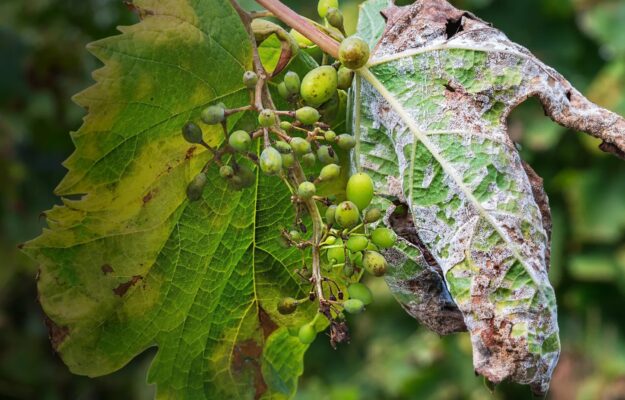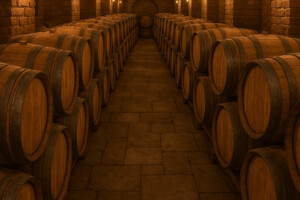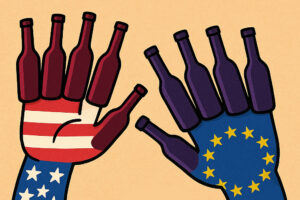Once the fear has passed, and the seasonal trend has normalized, with a summer that arrived a little later than usual, and with very high temperatures, the Italian vineyard, where the grapes are slowly changing color, is looking more confidently to the 2023 harvest. Which is unlikely to be counted among the great vintages of the century, but be careful not to be too hasty: the heavy hailstorms in the Northeast have created more than one problem, but the pressure of Downy mildew, while causing important losses on the production front, has no kind of consequence on the quality of the grapes. Which, from Tuscany to Sicily, thanks precisely to the rains of May and June, and the heat of the last few weeks, are looking good.
Is everything all right, then? No, and there is no need to stick our heads in the sand, but even less to recount with unjustified alarmism a difficult, challenging and exhausting season, which sometimes caught winemakers unprepared, or in the impossibility of doing better than that. In the vast majority of cases, especially in Tuscany, but also in the Marche and Abruzzo, producers have been able to respond in the right way to the emergency, entering the vineyard in sometimes precarious conditions, and making the best use of the technologies and knowledge at their disposal. Not everything, of course, is predictable, and familiarity with certain climatic and meteorological contexts - as demonstrated by the serenity of consortia in northern Italy, from Piedmont to Veneto - was certainly a factor. So has “promptness”, a word that recurs often, and says much about how vineyard management is bound to change.
The phytosanitary state of the grapes, as anticipated, is everywhere excellent, and this is certainly the best sign towards a harvest that will come into full swing only in a few weeks, after a thousand obstacles and difficulties, but with still intact the possibility and hope of bringing a great harvest to the cellar, although certainly lower than the quantitative average of recent years, especially in the Adriatic Regions. Everyone’s hope, of course, is that the next few days will hold no further surprises, with the thoughts and eyes of the winemakers constantly turned to the sky, and ears to the weather forecast...
“Downy mildew is not an unpredictable weather phenomenon, like hail, it is a fungus, and it is completely normal that under certain climatic conditions, of temperature and humidity, it occurs”, says Matteo Ascheri, president of the Consorzio di Barolo e Barbaresco, where “we are used to dealing with it every year, and as always we have been able to cope with the moments of greatest pressure by going into the vineyard even in the worst conditions imaginable, treating the rows manually where it was not possible to do otherwise. The long weeks of rain, however, have shown the limits of organic viticulture, with the need to use huge quantities of copper, cyclically washed away by the water. The need for an integrated approach that considers the use of synthetic products is becoming increasingly evident. If no disruptions happen, it’s a fantastic year for Barolo: although it was abundant, it rained at the right time, there were no problems with landslides or mudslides, and certainly the mostly family size of the wineries allowed a meticulous defense of the land”, Ascheri concludes.
No problems, on the Downy mildew front, for producers of Babera d’Asti and Monferrato wines, as Consortium president Vitaliano Maccario says: “Oidium also passed without causing any problems, while in some areas it was hailstorms that created the biggest problems. Also of concern continues to be the continuing drought, although in the last few days temperatures have normalized, with highs of 32 degrees during the day and cool weather in the evening, thus helping the vine to do its normal cycle. On the grape health front, so far we can consider ourselves fortunate, net of that 2-3% of vineyard areas affected by hail, essentially in the northern Asti area, in a patchy manner”.
Optimism filters through, at least for now, even among the rows of Moscato dell’Asti, where "Downy mildew, as well as other vine diseases, did not affect a significant percentage of our vineyards," says Giacomo Pondini, director of the Consorzio dell’Asti e Asti Spumante. “The hailstorm of July 8, on the other hand, mainly affected the western side, the one that looks to the Langhe, affecting 1-2% of the vineyards, with significant damage on some farms, but with a decidedly limited impact on the overall production of Moscato. As a Consortium, we are engaged in experimental harvests twice a week, with checks on the grapes and vineyards, without detecting any kind of health problem compared to our standards. So far”, Pondini concludes, “it is an absolutely normal vintage, with reassurances even from a quantitative point of view, thanks to the May rains. The accounts, as always, are made at the end, but the assumptions are good”.
Moving from Piedmont to Lombardy, the situation becomes a bit more complex. “To date we can say it is a difficult vintage to manage, but with interesting prospects”, says Silvano Brescianini, president of the Consorzio Franciacorta. “Hail and thunderstorms only barely hit us, now it's time to hold on until the harvest, in mid-August, trying to get the grapes to the winery as quickly as possible. In the last few months, we’ve seen it all: a frost affected 5% of the area under vines, then heavy rains during flowering brought with it some millerandage in the cluster, and a few episodes of downy mildew, but nothing glaring or worrisome, although the situation is far from uniform. As a quantity, as of now, we are between 10% and 20% above the 2022 harvest, but we still have 15-20 days ahead”.
In the Northeast, outlining a complete picture is Albino Armani, head of the Consorzio Tutela Vini Doc delle Venezie, which encompasses three regions - Veneto, Friuli Venezia-Giulia and Trentino Alto-Adige - and insists on the production area of as many as 21 different consortiums. “Here downy mildew has been a basically marginal problem, as has powdery mildew, despite the great pressure due to the rains, which, however, found us ready. The real concern is hail, which hit mainly in the Treviso area, the Venetian area, southern Lake Garda, and then Lugana and some areas of Garda and Bardolino. Moving further afield, there were also problems in the central-southern area of Friuli, while Trentino was essentially saved, as was upper Friuli, with the exception of small, circumscribed episodes. Overall, however, the situation cannot be said to be resolved, there is another storm coming, and in any case the criticality is constant, and presumably we will have to get used, in the future, to vintages like this one. The Consortia, with respect to these issues, must be ready in giving adequate solutions”, Albino Armani concludes.
Zooming in on the largest of the Italian sparkling wine appellations, that of Prosecco, “the situation between the rows, until the arrival of the hailstorms of the past few weeks - whose damages, in the affected areas, are still being estimated - appeared, all in all, positive, taking into account that Flavescenza Dorata was decidedly more contained than last year, while the other phytopathologies, where adequately treated, produced absolutely contained damage. More than phytosanitary conditions, the biggest concern is related to the weather in the coming weeks”, commented the director of the Consorzio del Prosecco, Luca Giavi.
Among the Unesco World Heritage Conegliano Valdobbiadene Prosecco Superiore vineyard hills, “the situation is patchy”, says Elvira Bortolomiol , president of the Consorzio Conegliano Valdobbiadene Prosecco Superiore. “There are areas a more affected by hail in the area of Valdobbiadene, Cartizze, Col San Martino, Oliano, the southern part of Vittorio Veneto: on average we are around 10% of the vineyard affected by hail. Given that, of course, does not correspond to what will be lost in terms of production, because there is still a long way to go and there is time to recover, we have not done real balances, we count on having more precise data in the coming days. On climate change we have been working on it for some time, with reservoirs to collect rainwater, for example, and we will ask for nets on the rows against hail, but we are also in a Unesco-protected area, and we will have to think well to understand what possibilities we have to safeguard production and territory. We founded our “Green Academy” in 2022, and we are doing research and studies to interpret the future from the perspective of climate change. Last year we suffered a lot from drought”, recalls Elivra Bortolomiol, “while this year there was a lot of rain, we have to adapt. As for Downy mildew, for now it is present only in sporadic cases, but we can consider it under control”.
From sparkling wines to great reds, staying in the Veneto region, but moving toward Verona, in Valpolicella the situation is decidedly more complex, also because of the peculiarities of wines made from dried grapes, such as Amarone and Ripasso, which, recalls the president of the Consorzio della Valpolicella, Christian Marchesini, “need light, sparse clusters, and not weighed down by water. The hope, in this sense, is that it will not rain again between now and the harvest, or at least that it will rain very little”. On the vine disease front, on the other hand, it was neither Downy mildew nor Powdery mildew that put vine growers in trouble, “but Esca disease, with a great incidence, evidently the result of the tropicalization of the climate. With last year's very dry weather it was manifesting itself under normal conditions, but with the rains of May and June it has become a major presence, and the solution is to cut the trunk of the vine in half, as used to be done in the past, to let air in and kill the fungi and anaerobic bacteria inside, hoping the plant will survive. It affects Guyot more, and sooner, than pergola, but the incidence is worrying because you lose not only a part of production, but also of the vineyard in view of the future”, Marchesini adds. Not alarming, finally, is the hail damage account, “which affected 20% of the southern part of the denomination, with damage estimated between 10 and 20%, so 4%, at most, of the Valpolicella vineyard”, concludes the president of the Consorzio della Valpolicella.
Remaining in Veneto, among the vine-covered hills of Soave, an “Agricultural Heritage Site of World Importance”, President Sandro Gini paints an all-too-silent picture, because “despite the heavy hailstorms, which affected 5% of our vineyards, but mostly affected homes and industrial sheds, the grapes are splendid and healthy, as are the leaves. We came from a particularly dry year, and we were afraid that the vines might find some difficulty at sprouting time, but instead the rain saved us, returning lush plants in splendid shape, totally recovered from the stress. We are looking forward”, Gini says again, “to an excellent year, both in terms of quantity, but without excess production, and quality. Besides Downy mildew, which was not a big problem anyway, powdery mildew, another disease that loves rain and heat, made itself felt, but it was successfully contained. The hope now is to get to the harvest without having to face other challenges”, concludes the president of the Soave Consortium.
Moving down the Peninsula, we finally arrive in Tuscany, in the largest red wine appellation in Italy, that of Chianti. A particularly vast territory, rich in diversity and therefore complex, where, as the president of the Consorzio del Vino Chianti Giovanni Busi reminds us, “we have not experienced a normal year since 2017: a year ago it was frost and drought that were the problems, this year it was rain, which led to significant pressure from Peronospora, which hit especially in vineyards with very tilled soils, where it was impossible to enter the field with rain, or among the rows of those producers who did not act promptly. In the Chianti territory, in general, we are talking about a productive loss of between 10 and 15%, but in the areas and wineries where we were able to give quick and adequate responses we are talking about 5% at most, while organic producers encountered some more difficulties”.
It is, therefore, an absolutely sustainable drop in production, especially in the context of Chianti, “where the Consortium had already asked the Region in April for a 10% cut in production to keep supply and demand in balance in a decidedly complex period at the global level”. The difference, more than the different areas, in this situation was made by individual wineries, with their decisions, thus returning to a “patchy” situation, just like with hailstorms. On the other hand, the positive aspect concerns the high temperatures, which have stopped both Downy mildew and powdery mildew, fungi that above 35 degrees have no chance to survive”, Busi concludes, recalling that, “regardless of the quantity to date the grapes are of excellent quality”.
Without moving too geographically, and focusing on a more limited area, the situation in Chianti Classico is not too different. “The main problem of this vintage is that the intense and continuous spring rains, if on the one hand they constitute an excellent water reserve, as we have not seen in a few years, on the other hand, with the arrival of hot weather, created ideal conditions for the development of fungal diseases, especially Downy mildew. Which has struck in a patchy way, similarly in different Uga, and with some randomness even in the same estate if not even in the same vineyard”, says the president of the Consorzio del Chianti Classico, Giovanni Manetti. “The emergency today is over, in good measure thanks to the heat of the past weeks, but also thanks to the great commitment put in by the winemakers: at certain times entering the vineyard was very difficult, but in the fight against Downy mildew, timeliness is everything. If from a quantitative point of view we can estimate a drop in production, in Chianti Classico, of 10-15%, it is good to remember that Downy mildew has no consequences on the qualitative side, so there are all the conditions to produce a great vintage. On the Powdery mildew front, on the other hand, there was no problem, also because when there is Downy mildew there is hardly any powdery mildew: the vine, and more generally the ecosystem, works like a box, and it is important to fill it with biodiversity, so as to leave less chance for pathogens to find space”, Giovanni Manetti concludes.
Remaining in Tuscany, in the territory of the precious Sangiovese of Brunello di Montalcino, after the fears of a few weeks ago, there is a return of optimism ahead of the next harvest. “Downy mildew is no longer a problem”, says the president of the Consorzio del Brunello di Montalcino, Fabrizio Bindocci. “We are at veraison time now, and the high temperatures, along with the Mistral, have defeated even the one present on the leaves. Some overhang is there - still difficult to quantify - but we are not talking about serious damage, probably around 5%, but on a very beautiful and productive vintage. Timing and foliage management, to combat Downy mildew, are key, but the future lies in plant disease-resistant varieties, which have been worked on for some time. Such a year, in terms of rainfall, is still exceptional, even in living memory. Even hail”, Bindocci concludes, “had an absolutely marginal impact, affecting a few shoots in the few hectares of vines affected.
From the rows of Nobile di Montepulciano, the president of the Consortium, Andrea Rossi, applauds the timing with which the winemakers of the denomination “have been able to respond to the attacks of Peronospora, in a difficult year, but one that we are dealing with as best we can. It is a situation made very difficult by the rains that fell between May and July, with limited and yet to be quantified damage, patchy, and a situation in any case in progress. There have been problems, but there is no reason to be catastrophic: on average, the territory has been able to react well, also because it has been able, over time, to equip itself with the right tools to interpret the weather and better manage the vineyards, such as the 42 weather stations throughout the denomination, accessible by all the wineries”, concludes the president of the Consorzio del Nobile di Montepulciano.
The context definitely improves as we move from the hinterland to the coast, to vineyards no longer or not only of Sangiovese, but of Cabernet Sauvignon, Cabernet Franc and Merlot, that is, those that have made Bolgheri great. Where “the situation seems to be quiet”, says Albiera Antinori, who heads, along with Priscilla Incisa della Rocchetta and Cinzia Merli, the Consorzio del Bolgheri. “Obviously there were some problems with downy mildew, but not as strong as in other areas of Tuscany, and then with the heat it stopped. Most producers have worked well, there are sporadic cases of Downy mildew, but nothing dramatic. We hypothesize a general drop in grape production that may reach a maximum of 20% in some vineyards, but it is difficult to make a precise estimate now. However, the situation is calm, there have been no particular problems with adverse rains in the spring, and Bolgheri is used to handling the heat, also because there has been no lack of water resources, so we can work calmly in view of the harvest”, concludes Albiera Antinori.
Among the regions that have had to deal more than others with the climatic extremes is Marche, which by its very nature is plural and, as the director of the Istituto Marchigiano Tutela Vini, the consortium that brings together the regional wine DOCs, recalls, “therefore returns a very fragmented and patchy reality. The only certainty is that the area most affected is Matelica, where rains fell incessantly for 21 consecutive days in June, making it impossible in many cases to enter the vineyard. We have deployed all the technologies at our disposal, but we have often seen cases of neighboring vineyards in very different conditions. The situation is by no means tragic, and very varied, certainly there will be a loss of product, quantifiable at 20-25%, but these warm and windy weeks have allowed us to overcome the emergency, and the plants that have not been affected by Downy mildew are approaching the harvest without problems”. Even in the Marche, Mazzoni emphasizes, “timing has made a difference, and nothing changes in this regard between organic and conventional viticulture. Technology gives us exceptional sprayers and 4.0 tractors, but it is not always enough to save everyone. We ran into a fierce attack, but the reaction was just as strong”, concludes the director of the Istituto Marchigiano Tutela Vini.
Moving down the Adriatic coast, in Abruzzo “we were hit by Downy mildew, as happened in so many other areas of Italy”, says Alessandro Nicodemi, president of the Consorzio Vini d’Abruzzo. “The damage was there in quantity, but the clusters left on the vine, in a hot and rainy year, especially in May, are beautiful and in good condition, and today we see a vineyard that is experiencing a really optimal vegetative phase. We can estimate the harvest loss, in the four provinces of the region, at around -30%, but as always we will do the accounts when the grapes are in the cellar”.
Francesco Liantonio, president of the Consorzio Castel del Monte, Apulia’s oenological heart, speaks of an all-too-predictable context, according to which “the peculiarity of this vintage is related to climate change: more than worrying, we have to get used to these climatic situations, classic of an almost tropical climate, with heavy water and storms in May and June, so much so that Peronospora saw great attacks throughout Apulia. Then it was the turn of the scorching heat, with highs of 43-45 degrees, very high for the vines, which from so much water found themselves almost suffocated by the heat. But this is nothing new, and we have to get used to handling them. I always hope that in the end we will have important results, albeit in the face of a major drop in the harvest, between Downy mildew and heat, which, where possible, we have made up for with relief irrigation”, Liantonio says again.
Looking, more specifically, at Castel del Monte, things are improving: “it is a happy island, with vineyards on high ground and very well-drained, rocky limestone soils, where we have been able to combat the effects of the rains much better, and in fact the pressure of Downy mildew has not been excessive, and the situation is under control. The hillsides enjoy the sea breeze, through which we are able to mitigate the effect of humidity, and this facilitates us, and the same goes for the high temperatures, which are rebalanced by significant temperature ranges of 15-20 degrees, which facilitate the ripening of the grapes. For Castel del Monte I am not worried, we are hoping for an exceptional harvest in quality, again this year, and a more regular August from a climatic point of view, without extreme events. Our first estimates speak of a drop in the harvest, in Puglia, of 10-20%, but now in the vineyard things are going well, and with a regular August and September we can still recover something. In the Castel del Monte area, given the peculiar conditions we have been talking about, with the same caution I would say that we will settle on a production drop of -5%-10%”, concludes the president of the Consorzio Castel del Monte.
Our journey through the rows of Italy can only end in Sicily, where the two sides of the same coin, that of climatic excesses, come together: on the one hand the rains, which caused increased pressure from fungal diseases, and on the other the heat waves, which burned the grapes. “This has been a particularly complex vintage because, already since last fall and winter, we have been working under very particular climatic conditions, which we can define as “un-Sicilian”, comments Antonio Rallo, president of the Consorzio della Doc Sicilia. “More frequent and very intense rains involved an environmental context characterized by a normally much drier climate. The spring and summer rains have certainly been useful in building up water reserves in the soils and reservoirs, an additional safeguard in defending the plants from the great heat of recent weeks. Grape ripening is delayed by about a week. The expected drop in production is around 35% we remain positive about the quality level of this vintage”, concludes Antonio Rallo.
Copyright © 2000/2025
Contatti: info@winenews.it
Seguici anche su Twitter: @WineNewsIt
Seguici anche su Facebook: @winenewsit
Questo articolo è tratto dall'archivio di WineNews - Tutti i diritti riservati - Copyright © 2000/2025

























































































































































































